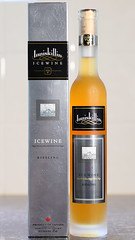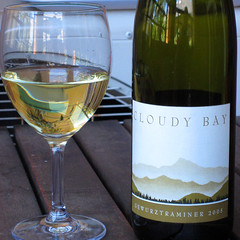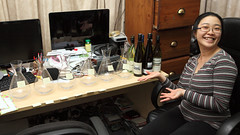 Last night we held the wine tasting night which I described a few days ago.
Last night we held the wine tasting night which I described a few days ago.
We had a total of 12 people participating, and six white wines to taste. Veronica got the job of decanting the wines into the set of identical decanters we bought. We labelled the decanters with letters (A through F) using Post-it notes. Veronica was sequestered in a room with a green filter placed over the light so she couldn’t distinguish the colours of the wines as she was pouring them. She wrote down a mapping from the wines to the letters, and kept this secret from everyone else.
Veronica then left the secret room and Steven went in. He wrote down a shuffled mapping from letters (A to F) to numbers (1 to 6). He then replaced the letters on the decanters with the corresponding numbers and kept his piece of paper with the mapping secret. Then we brought the decanters out to the dining table, where everyone had six wine glasses of their own (brought from home).
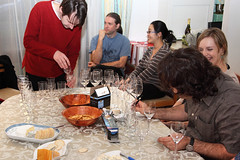 Meanwhile, we’d all labelled our glasses with Post-its or stickers, numbered 1 to 6 to match the decanters. And while doing all this we were snacking on cheese and crackers. There was a King Island brie, some sort of soft, mild blue cheese, and a matured cheddar. The crackers were intended to be useful during the tasting, to cleanse palates in between sips of the various different wines.
Meanwhile, we’d all labelled our glasses with Post-its or stickers, numbered 1 to 6 to match the decanters. And while doing all this we were snacking on cheese and crackers. There was a King Island brie, some sort of soft, mild blue cheese, and a matured cheddar. The crackers were intended to be useful during the tasting, to cleanse palates in between sips of the various different wines.
We passed the decanters around the table so everyone could pour a sample of each wine into their own matching numbered glass. Once that was done, I (having bought the wines) announced to everyone what the six different types of wine were. And then we began tasting.
We have a mixed amount of experience with wine. David Mc’s uncle owns a winery in the Hunter Valley, and he probably knows more about wine than any of the rest of us, though he’d admit he’s no expert. I’ve been trying to learn, but less than a year of experience is not a lot when it comes to the complexity of what lay before us. The list of wines again, for reference:
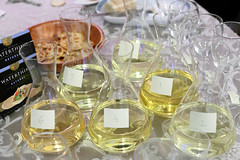
- Wither Hills 2009 Wairau Valley Sauvignon Blanc
- Brokenwood 2008 Hunter Valley Semillon
- Wynns 2008 Connawarra Estate Riesling
- Gramp’s 2006 Barossa Chardonnay
- Brown Brothers 2009 King Valley Pinot Grigio
- Pewsey Vale 2008 Eden Valley Gewürtztraminer
The goal was not to be competitive and try to identify the wines, but simply to discuss our impressions of them and see if we could get most people agreeing on various characteristics and descriptors, helping the less experienced people to find the right vocabulary to describe the aromas and tastes. And of course for everyone to actually have six different wines in front of them to assist in making immediate comparisons and get a handle on the variety of flavours that are possible.
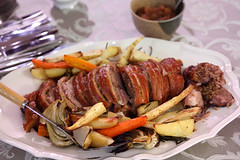 Of course this didn’t stop some of us from trying to identify the wines. This resulted in some hilarity later on when we revealed what the wines were, but more about that in a minute. The first thing that was agreed on by those with some wine experience was that Wine #1 was the Chardonnay. The oaky, woody flavour stood out, and even the people with little experience agreed it was very different from all the rest of the wines.
Of course this didn’t stop some of us from trying to identify the wines. This resulted in some hilarity later on when we revealed what the wines were, but more about that in a minute. The first thing that was agreed on by those with some wine experience was that Wine #1 was the Chardonnay. The oaky, woody flavour stood out, and even the people with little experience agreed it was very different from all the rest of the wines.
I actually started tasting from #6, since M. was sharing our glasses and started at the other end. A sniff of #6 brought to mind the distinctive piercing, minerally small of Riesling. A sip confirmed this in my mind, and I locked that in as an identification. This turned out to be a critical error. Working my way backwards, I found #5 to be very acidic and lemony. I thought I could detect the grassy, herbaceous qualities of Sauvignon blanc, and wrote that down. But #4 made me doubt that identification, as it turned out to be very similar at first taste. There was a bit of discussion about how similar #4 and #5 were, and Tina came up with the observation that while they were both citrusy, #4 had a slightly bitter citrus peel aftertaste, that #5 lacked.
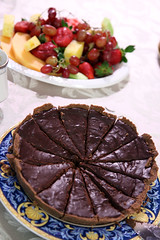 Working may way back through the numbers, #3 had me baffled. By now my confidence in identifying at least 2 or 3 of the wines was being eroded. I think I wrote a tentative Semillon for #3, mainly because I have very little experience with Semillon. #2 seemed to have a very floral aroma, which I associate with Gewürztraminer. Others agreed in discussion. I then tasted it, looking for the spiciness that I expected, and found a hint of it – probably more through expectation than anything else – so I wrote down another identification.
Working may way back through the numbers, #3 had me baffled. By now my confidence in identifying at least 2 or 3 of the wines was being eroded. I think I wrote a tentative Semillon for #3, mainly because I have very little experience with Semillon. #2 seemed to have a very floral aroma, which I associate with Gewürztraminer. Others agreed in discussion. I then tasted it, looking for the spiciness that I expected, and found a hint of it – probably more through expectation than anything else – so I wrote down another identification.
The discussion was lively, with everyone throwing in opinions and flavour words like “peachy”, “lychees”, and so on, as well as quite a bit of, “Oh, this has a distinctive smell… what is it?” The main observation about the colours of the wines was that #6 was much more pink than any of the others, but this bit of information didn’t illuminate anything for us.
When we’d had enough discussion, Andrew S. grabbed the wine bottles and read out the descriptions on the back labels. They included the usual references to various fruits and so on, and some people made notes and tried to adjust their guesses of which wine might be which based on this new information. My list looked like this:
- Chardonnay
- Gewürztraminer?
- Semillon??
- Pinot grigio?
- Sauvignon Blanc?
- Riesling
I was positive I’d got the Chardonnay and Riesling right, and moderately sure about the Sauvignon blanc and Gewürztraminer. The Pinot grigio I’d assigned based on nothing other than David Mc’s telling me a few weeks ago that it was a bit like Sauvignon blanc – I’d never tried this grape myself yet. The wine label reading didn’t really illuminate anything new for me.
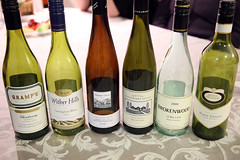 Then came the moment of truth. Veronica and Steven colluded and came up with the mapping from numbers back via letters to the wines. Here is what they were (also see the photo, where the bottles are shown in order, left to right):
Then came the moment of truth. Veronica and Steven colluded and came up with the mapping from numbers back via letters to the wines. Here is what they were (also see the photo, where the bottles are shown in order, left to right):
- Chardonnay
- Sauvignon Blanc
- Gewürztraminer
- Riesling
- Semillon
- Pinot grigio
Yeah, I got a measly one right. David Mc got the Chardonnay and the Semillon – he’d pointed out that a young Semillon is very citrusy and acidic, with hints of buttery and nutty flavours underneath that come out with age as the acidity dies away. His experience there was a big advantage. Steven, who went in claiming to know virtually nothing about wines, had based his guesses entirely on the wine label reading stage compared to the notes he’d made – and he scored 6 out of 6, much better than anyone else! In hindsight, my big mistake was nailing down the Riesling at the first taste of #6, which blinded me to the fact that #4 also displayed the distinctive Riesling notes. Basically, as far as my identifying skills go, this was pretty much a debacle! I’ll have to be more circumspect and careful next time, when we attempt red wine varietals.
After the tasting, we enjoyed a wonderful dinner together, with a fantastic pork roast by Tina, spinach and pine nut pasta by Andrew S, chili chicken wings by Andrew C, lasagne by David K and Christine, followed by a chocolate tart by M. and me, with fresh fruit brought by Loki and Rach. All together it was a great evening. I think we all learnt a lot about our experience with the wines, some of us learning we knew less than we thought we did, and others getting more up to speed with tasting and terminology. A resounding success!



